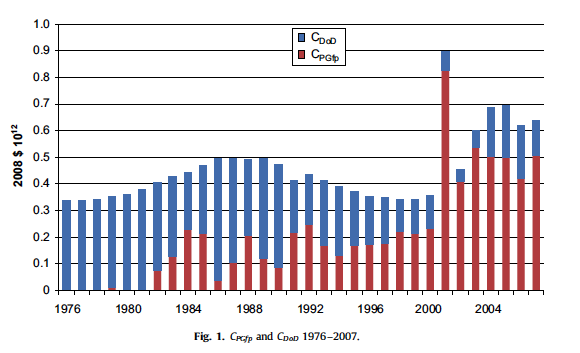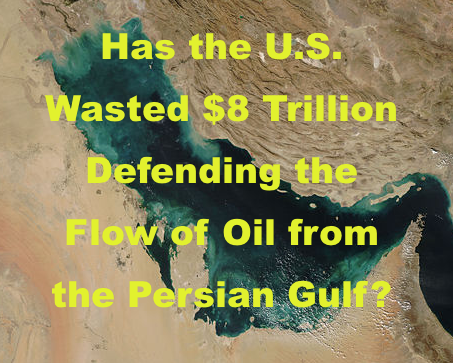Last week, Defense Secretary Robert Gates argued that President Obama’s order to cut $400 billion from national-security spending over the next 12 years will force the U.S. military to curtail some of its far-flung duties. “This needs to be a process that is driven by the analysis,” he said, “as well as missions that our elected officials decide we should not have to perform, or can’t perform anymore, because we don’t have the resources.”
Well, even a blind pig finds an acorn once in awhile. While working on a recent piece on how to cut $1 trillion from the $7-trillion-plus U.S. defense budget over the coming decade, I stumbled upon a provocative analysis by Roger Stern, an economic geographer at Princeton University. He says the U.S. has “mis-allocated” — others might say “wasted” — $8 trillion since 1976 protecting the oil flow from the Persian Gulf that fuels much of the global economy. Especially since in 2010, when the U.S. was the destination of less than 10 percent of the oil flowing out of the Gulf.
The U.S. has insisted, since the days of the Carter Administration, that the oil flowing out of the Persian Gulf is a vital national-security interest of the U.S. Beyond that, Presidents and the Pentagon have said, the narrow Strait of Hormuz is a vulnerable bottleneck for shipping headed out of the Gulf. Any troublemaker — especially Iran — could bring the U.S. and world economies to their collective knees by shutting it down by sinking a couple of tankers as they pass through. Consequently, the U.S. has poured tons of money into the region since then, including three wars. It has bulked up its military forces in the neighborhood — including the U.S. Navy’s 5th Fleet, headquarters in Bahrain, smack dab in the middle of the gulf — to keep the oil flowing.
Balderdash, says Stern. He uses more technical terms, but his bottom line is the same: Iran and other nations in the region have just as much, if not more, need to keep the oil flowing than the U.S. Think of it as your right hand — angry at your left hand for some casus belli — pinching their shared aorta to punish the left hand. Both would quickly begin turning blue. More critically, Stern argues, the U.S. military’s emphasis on the Gulf has diverted precious defense resources away from the western Pacific, where China poses a far graver long-term threat to American interests.
“On an annual basis, the Persian Gulf mission now costs about as much as did the Cold War,” Stern says in his paper, which appeared in Energy Policy, a peer-reviewed scholarly journal, in April 2010 to scant notice. He also suggested it could be costly in more ways than one: “Without the extensive long-term US military presence in the Persian Gulf, it seems an open question whether anti-US suicide terrorism such as the USS Cole and 9/11 attacks would have taken place.”

Stern's estimate of the annual cost to the U.S. military of defending the flow of oil from the Persian Gulf
Stern’s paper pegs the cost of the U.S. military presence in the Gulf from 1976 to 2007 at $6.8 trillion. Last week, he estimated — at Battleland’s request — that the cost through 2010 was about $8 trillion.
The Persian Gulf mission pins down the U.S. military, Stern maintains. “The massive investment in Persian Gulf force projection essentially precludes U.S. ability to project force elsewhere,” he says. “China understands this perfectly, even if we don’t.” Indeed, Major General Yin Zhuo, director of China’s navy information committee, noted this recently. “It will take the United States a fairly long period of time to return to Asia. Anti-terrorist wars still constrain U.S. power,” he said. “China needs to grasp this strategic opportunity firmly.”
“If Saudi Arabia felt its oil supply were threatened by Iran, it would do what Iraq did during the Iran-Iraq War — build pipelines around the Strait of Hormuz,” Stern says. “We’re too stupid to grasp this. National-security experts in government, academia and non-governmental organizations know very little about the actual business of energy.”
No kidding. Battleland asked the Department of Energy to detail where the vessels leaving the Persian Gulf were bound in 2010. Saturday, it provided the list, which DOE said is not generally made public. Wonder why? Just take a look at the destination for the oil flowing out of the Persian Gulf last year:
Japan – 20.1%
China – 14.4%
India – 13.2%
South Korea – 12.9%
U.S. – 9.8%
Singapore – 5.3%
Taiwan – 4.5%
Thailand – 3.5%
The Netherlands – 1.9%
South Africa – 1.6%
Do the math: the U.S. is spending trillions to protect the flow of oil from the Persian Gulf, when last year it received less than 10 percent of that oil. So even — if the heavy U.S. investment in protecting the Persian Gulf pipeline makes sense — why is it shouldering close to 100% of the cost of protecting it while countries (and commercial competitors) like Japan, China, India and South Korea get a free ride?
The Gulf oil states don’t have much else to export to earn hard foreign currency. “So they’re not states that can afford to decline to sell — or even cut the supply — and that includes Iran most of all,” Stern says. “It has few friends, and many of those are energy investors from Asia” intent on keeping the Strait of Hormuz — the world’s biggest oil spigot — open.
“It’s not that Iran is this perfectly rational place and they couldn’t close the Strait of Hormuz — it’s simply that we’ve ceased asking the question: `Well, the supply is not invulnerable, but what is the probability that it is going to be interrupted?'” Stern adds. “We have long assumed that because it could be cut, it will be cut, and plans are made accordingly. But not all threats are equally likely.
“The idea of a vulnerable supply is the central illusion of our policy over the past hundred years or so,” Stern says. “There is a risk of disruption, but not nearly so high that we should have had an aircraft carrier battle group continuously on station in the Persian Gulf for the past 21 years.”
Stern says he has discussed his paper with small groups at the Pentagon and the U.S. Naval Academy without generating an uproar. Perhaps it’s time his assertions questioning the merit of the U.S. military’s current strategy in the Persian Gulf trigger a broader debate.



